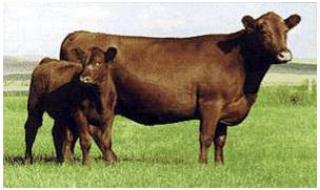Neosporosis - A major cause of abortion in cattle
Published on 13 August 2012 in Food, health and wellbeing

Introduction
Neosporosis is caused by a single celled protozoan parasite called Neospora caninum and is a major cause of abortion in cattle across the UK and worldwide. Neospora affects both beef and dairy cattle and abortions may present in clusters (epidemic outbreaks) or as sporadic cases. Infected cattle are 3-7 times more likely to abort compared to un-infected cattle.
Neospora has been the most commonly detected and attributed cause of bovine abortion in UK in recent years. Economic losses associated with neosporosis include stillbirth/neonatal mortality, early foetal death, increased calving interval, increased culling, reduced milk production and reduced value of breeding stock. The disease has proved to be challenging to control due to its complex lifecycle within the cow and the fact the Neospora caninum oocysts (eggs) may persist for long periods of time in an infectious form in the environment.
Neospora can infect cattle by two main routes: dog to cattle and dam to calf - during pregnancy. Dog to cattle transmission occurs when cattle ingest Neospora oocysts in contaminated feed, water or from pasture. As a result, animals may become infected simultaneously, which can lead to abortion storms, where many cattle lose their foetuses within a short period. Dam to calf transmission may occur by two separate routes: 1) when the parasite, from a previous infection, is reactivated in the dam during pregnancy and 2) if the dam is newly infected with Neospora during pregnancy. In both cases the unborn calves become infected in utero. If the foetus survives the infection then they are born congenitally infected but may appear clinically normal. Infected heifers can transmit Neospora to their offspring in subsequent pregnancies. This transmission route is very effective and Neospora may be maintained within a herd for many generations.
Key Points
- Neosporosis is an important infectious disease of cattle worldwide that results in abortion and stillbirth
- Neospora eggs (oocysts) are shed by infected dogs in their faeces and are a source of infection for cattle
- Infection in cattle is common and may be frequently spread from mother to calf during pregnancy and is often passed over several generations
- Disease occurs when Neospora invades and multiplies within the placenta and foetus causing foetal death
- Control of Neospora is difficult. Knowledge of transmission routes and epidemiology have helped to inform biosecurity and on farm management strategies
- Cattle having experienced abortion due to Neospora are less likely to abort again, although the likelihood of vertical transmission in Neospora infected cattle is very high, resulting in efficient spread of the pathogen in herds
Research Undertaken
Research at Moredun to further understanding of the pathogenesis of disease has shown that timing of infection during pregnancy is critical in determining disease outcomes. If infection occurs early in gestation then this may result in re-absorption of foetus, foetal death or abortion. However, if infection occurs in late gestation then this is more likely to result in the birth of infected but otherwise clinically normal calves.
Diagnosis of neosporosis is usually confirmed by pathological examination of foetuses and placentas. This is often hindered by the poor condition of the foetus/placenta or material not being submitted for diagnosis. Moredun has developed a highly sensitive molecular based test to allow the rapid diagnosis of Neospora in cattle tissues. A survey carried out on bovine abortion samples across Scotland (n=611) found that nearly 20% were positive using a new molecular based diagnostic test recently developed at Moredun Research Institute.
Blood testing to look for Neospora-specific antibodies may be used to provide further supporting evidence when suspecting neosporosis in cattle. Accurate determination of the infection status of cattle is highly desirable when purchasing animals or as part of prevention and control strategies. However, current Neospora specific blood tests detect antibodies, which recognise the active form (tachyzoite) of the parasite. When the parasite differentiates into its persistent form in the host, antibody levels against tachyzoites can drop below detection level, resulting in false negatives. Therefore scientists at Moredun are looking to develop a new diagnostic using the persistent stage of the parasite as the antigen which is more likely to detect persistently infected carrier animals.
There are no vaccines or effective treatments against neosporosis in the UK at this time. Moredun is currently conducting research to develop a vaccine to prevent Neospora associated abortion in cattle. Experimental infection of cattle prior to mating induced protective immunity against a challenge administered during gestation giving impetus to the development of a vaccine to help protect cattle against disease. Current control options for neosporosis are limited to farm management practices. The best strategies are to avoid importing the parasite onto the farm via infected cattle, and if it is already present then try to minimise its impact. To minimise the spread of the disease, dogs should be kept away from pregnant cattle and calving areas and from cattle feed & water. Other approaches have focused on breeding out Neospora infection from the herd by choosing replacement stock from uninfected dams.
Policy Implications
Neospora caninum is one of the most important infectious causes of bovine abortion in UK and worldwide. Reproductive failure is a major constraint to livestock producers resulting in significant economic losses and reducing the efficiency and sustainability of cattle production. This research to prevent and control disease will increase the sustainable efficiency of livestock production, improve animal welfare and reduce impact on the environment.
Author
Professor Elisabeth A. Innes lee.innes@moredun.ac.uk





